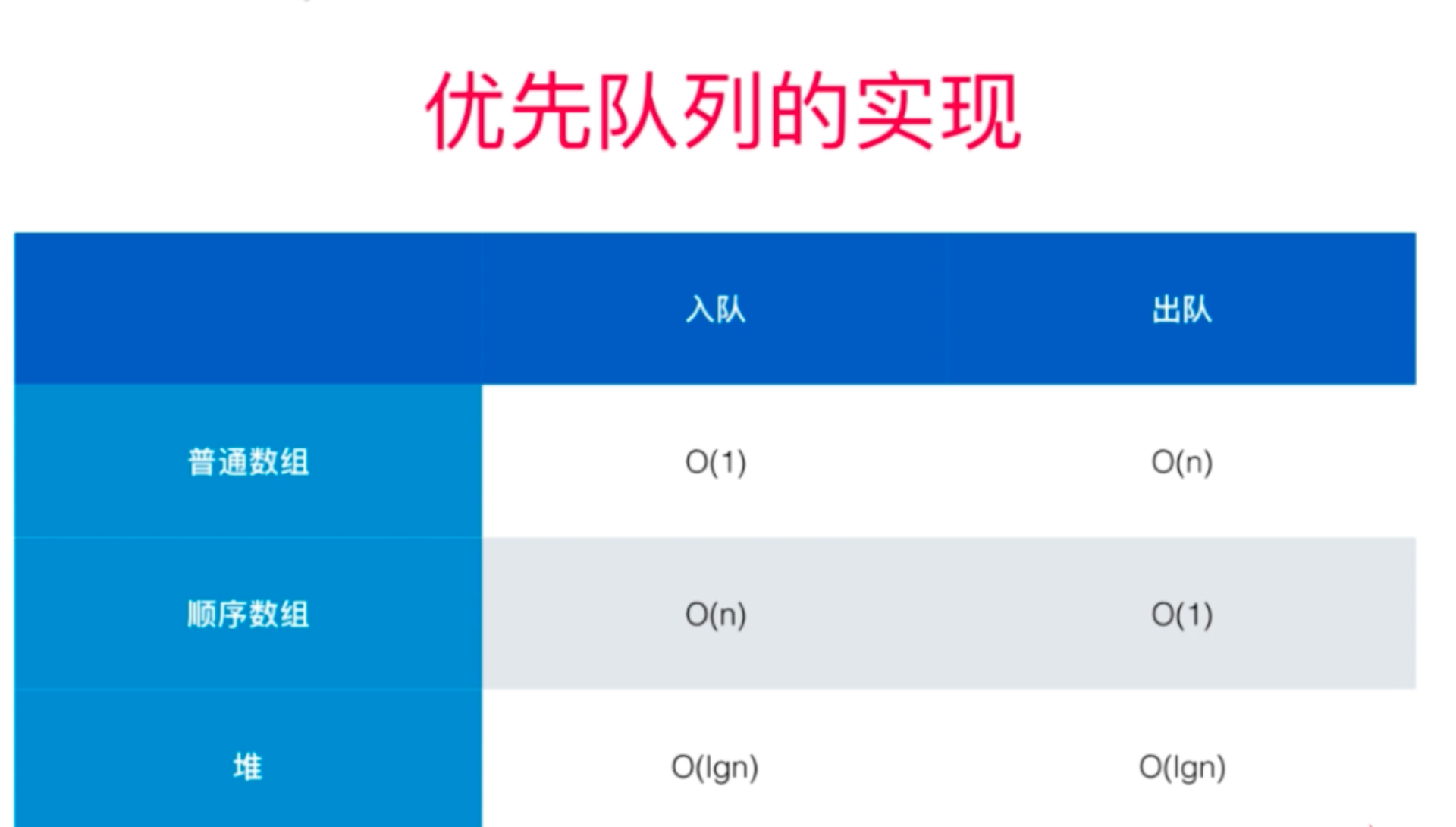一、介绍
堆,也是计算中一种很常用的数据结构,它以树的形式存在。 对于树的结构,因为有父节点和子节点的概念,所以一般通过父指针和子指针来实现。但是,也有一种特殊的树不需要使用指针而可以直接通过数组来实现,这种树就是完全二叉树(除了最后一层不用全满,其他层必须全满,而且最后一层的叶子结点都靠左对齐)。今天我们要讨论的二叉堆就是一棵完全二叉树,二叉堆也是堆的一种,只不过二叉堆拥有自己的特点,它分为最大堆和最小堆。
二叉堆特点:
最大堆:所有的父节点值都不小于其孩子节点值。(注意“其”字,仅限于当前父节点和它的子节点的比较)
最小堆:所有的父节点值都不大于其孩子节点值。(注意“其”字,仅限于当前父节点和它的子节点的比较)
算法: parent = floor(i/2),leftChild = 2*i, rightChild = 2*i+1 [注意: 存储的角标从1开始]。
二叉堆图示:


二、使用
之前的篇幅介绍过链队列和顺序队列,它们都是普通的队列,采用先进先出的方式来对元素进行操作。可是,有的时候需求并不是仅仅如此,可能会来一个优先级更高的元素操作,这个时候把它按照普通队列的方式进行处理明显是不合适的。而且,普通队列的入队和出队的时间复杂度也不是最优的。此时采用二叉堆构建优先队列,是一个折中的选择,时间复杂度是最优的,如图所示:

三、代码
定义
#include <iostream>
#include <stdlib.h>
#include <math.h>
#include <algorithm>
using namespace std;
#define QUEUE_OVERFLOW -1
#define OK 1
#define ERROR 0
typedef int Status;
typedef int QElemType;
typedef struct BinaryHeap {
int capacity; //容量
int count; //个数
QElemType *array; //数组
}BinaryHeapQueue;
//构建二叉堆优先队列
Status constructBinaryHeapQueue(BinaryHeapQueue &bq, int capacity);
//将元素添加到队列
Status enQueueByShiftUp(BinaryHeapQueue &bq, QElemType e);
//从队列中取出元素
Status deQueueByShiftDown(BinaryHeapQueue &bqt);
//获取队列元素个数
QElemType eleCount(BinaryHeapQueue &bq);
//判断队列是否为空
Status isEmpty(BinaryHeapQueue &bq);
//判断队列是否已满
Status isFull(BinaryHeapQueue &bq);
实现
//构建一个二叉堆
Status constructBinaryHeapQueue(BinaryHeapQueue &bq, int capacity) {
assert(capacity > 0);
//数组元素从下标1的位置开始存储,所以多分配一块内存
bq.array = (QElemType *)malloc((capacity + 1) * sizeof(QElemType));
bq.capacity = capacity+1;
bq.count = 0;
if (!bq.array) exit(QUEUE_OVERFLOW); //存储分配失败
return OK;
}
//将元素e添加队列
Status enQueueByShiftUp(BinaryHeapQueue &bq, QElemType e) {
if (isFull(bq)){
cout<<"队列已满,当前元素: "<<e<<" 无法被添加到队列"<<endl;
return ERROR;
}
//保存元素
bq.array[bq.count+1] = e;
cout<<"入队列元素: "<<"array["<<bq.count+1<<"] = "<<e<<endl;
//如果这个入队元素的值是比父节点值大,则往上移动
int chiIndex = bq.count + 1;
int parIndex = floor(chiIndex/2);
while (bq.array[parIndex] < bq.array[chiIndex] && parIndex > 0) {
swap(bq.array[parIndex], bq.array[chiIndex]);
chiIndex = parIndex;
parIndex = floor(chiIndex / 2);
}
//个数自增
bq.count ++;
return OK;
}
//从队列中取出队首元素保存到e中
Status deQueueByShiftDown(BinaryHeapQueue &bq) {
if (isEmpty(bq)){
cout<<"队列已空"<<endl;
return ERROR;
}
//取出元素
QElemType e = bq.array[1];
bq.array[1] = bq.array[bq.count];
cout<<"出队列元素: "<<"array[1] = "<<e<<endl;
//个数自减
bq.count --;
//如果将尾部元素放到下标1位置的值是比孩子节点小,则往下移动
int parIndex = 1;
int l_chiIndex = parIndex * 2;
int r_chiIndex = parIndex * 2 + 1;
while (r_chiIndex <= bq.count && bq.count > 1){
if (bq.array[parIndex] <= bq.array[l_chiIndex] || bq.array[parIndex] <= bq.array[r_chiIndex]) {
//左孩子比右孩子值大,父节点和左孩子交换
if (bq.array[l_chiIndex] > bq.array[r_chiIndex]) {
swap(bq.array[parIndex],bq.array[l_chiIndex]);
parIndex = l_chiIndex;
} else {
swap(bq.array[parIndex],bq.array[r_chiIndex]);
parIndex = r_chiIndex;
}
l_chiIndex = parIndex * 2;
r_chiIndex = parIndex * 2 + 1;
}
}
return OK;
}
//获取队列元素个数
QElemType eleCount(BinaryHeapQueue &bq) {
QElemType count = bq.count;
cout<<"队列元素个数: count = "<<count<<endl;
return count;
}
//判断队列是否为空
Status isEmpty(BinaryHeapQueue &bq) {
return bq.count == 0;
}
//判断队列是否已满
Status isFull(BinaryHeapQueue &bq) {
return bq.count == bq.capacity-1;
}
四、结果
测试
int main() {
///创建二叉堆优先队列(本代码以最大堆为例) ------ 最小堆实现逻辑与其类似
BinaryHeapQueue heapQueue;
constructBinaryHeapQueue(heapQueue, 5);
///添加元素到队列
enQueueByShiftUp(heapQueue, 60);
enQueueByShiftUp(heapQueue, 23);
enQueueByShiftUp(heapQueue, 40);
enQueueByShiftUp(heapQueue, 60);
enQueueByShiftUp(heapQueue, 80);
///获取元素的个数
eleCount(heapQueue);
///先取出一个元素,再入队两个元素
cout<<endl;
deQueueByShiftDown(heapQueue);
enQueueByShiftUp(heapQueue, 100);
enQueueByShiftUp(heapQueue, 200);
///获取元素的个数
eleCount(heapQueue);
cout<<endl;
///取出元素从队列
deQueueByShiftDown(heapQueue);
deQueueByShiftDown(heapQueue);
deQueueByShiftDown(heapQueue);
deQueueByShiftDown(heapQueue);
deQueueByShiftDown(heapQueue);
deQueueByShiftDown(heapQueue);
///获取元素的个数
eleCount(heapQueue);
return 0;
}
打印
/Users/xiayuanquan/CLionProjects/treeHeap/cmake-build-debug/treeHeap 入队列元素: array[1] = 60 入队列元素: array[2] = 23 入队列元素: array[3] = 40 入队列元素: array[4] = 60 入队列元素: array[5] = 80 队列元素个数: count = 5 出队列元素: array[1] = 80 入队列元素: array[5] = 100 队列已满,当前元素: 200 无法被添加到队列 队列元素个数: count = 5 出队列元素: array[1] = 100 出队列元素: array[1] = 60 出队列元素: array[1] = 60 出队列元素: array[1] = 40 出队列元素: array[1] = 23 队列已空 队列元素个数: count = 0 进程已结束,退出代码 0